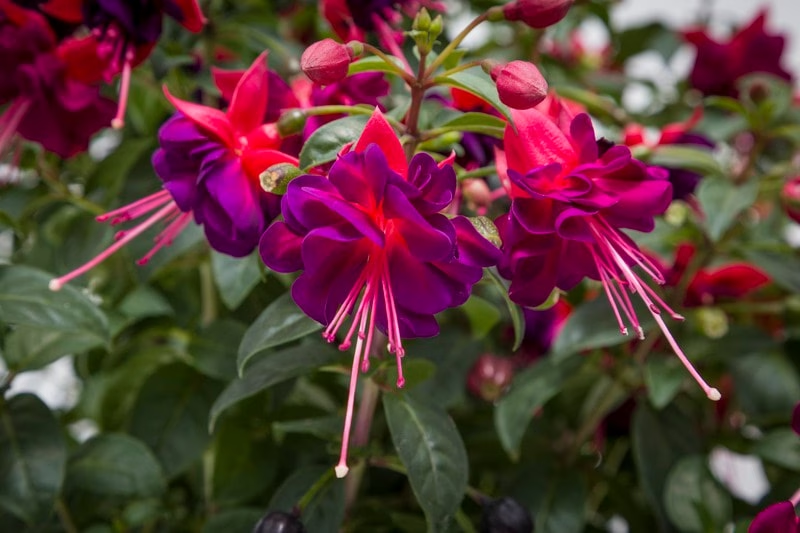
Dark Eyes Fuchsia
Botanical Name
:
Fuchsia hybrid ‘Dark Eyes’
Plant Type
:
Deciduous shrub, often grown as an annual in colder climates.
Seasons
:
Spring, Summer, Autumn
Sun Level
:
Partial shade to full sun, ideally 4–6 hours of direct sunlight per day
Ideal Soil Temperature for Planting
:
60–75°F (15–24°C)
Soil Type
:
Moist, well-draining, rich in organic matter/Moist but well-drained soil; can thrive in chalk, clay, loam, or sand.
Germination
:
Typically propagated through cuttings rather than seeds; seeds take 1–4 months to germinate, while cuttings develop roots in 6–8 weeks
P.H. Level
:
6.0–7.0
Water/Irrigation
:
Keep soil consistently moist but avoid overwatering.
Fertilization
:
Apply a balanced liquid fertilizer every 2–4 weeks during the growing season
Habit
:
Bushy and upright when grown as a shrub but trailing when used in hanging baskets.
Final Plant Height
:
12–18 inches (30–45 cm)
Spread
:
18–24 inches (45 to 60 cm)
Spacing
:
12 to 16 inches (30–40 cm)
Flowers
:
Large, double-layered blooms with bright red sepals and deep purple corollas.
Attracts
:
Hummingbirds, butterflies, and bees.
Uses
:
Hanging baskets, containers, garden borders, pollinator gardens
Companions
:
Begonias, impatiens, coleus, lobelia
Pruning
:
Prune in late winter or early spring for new growth; deadhead spent flowers regularly for continuous blooming.
Toxicity
:
Non-toxic to humans but mildly toxic to pets if ingested.
Pests
:
It is susceptible to aphids, fuchsia gall mites, fuchsia flea beetles, capsid bugs, and vine weevils. Treat it with insecticidal soap or neem oil.
Diseases
:
It is susceptible to Botrytis (gray mold), powdery mildew, root rot, and fungal leaf spots. To prevent these diseases, ensure good air circulation and avoid overhead watering.
Did You Know?
The flowers of Dark Eyes Fuchsia are edible and can be used as decorative garnishes in salads or desserts.
Botanical Name
:
Fuchsia hybrid ‘Dark Eyes’
Plant Type
:
Deciduous shrub, often grown as an annual in colder climates.
Seasons
:
Spring, Summer, Autumn
Sun Level
:
Partial shade to full sun, ideally 4–6 hours of direct sunlight per day
Ideal Soil Temperature for Planting
:
60–75°F (15–24°C)
Soil Type
:
Moist, well-draining, rich in organic matter/Moist but well-drained soil; can thrive in chalk, clay, loam, or sand.
Germination
:
Typically propagated through cuttings rather than seeds; seeds take 1–4 months to germinate, while cuttings develop roots in 6–8 weeks
P.H. Level
:
6.0–7.0
Water/Irrigation
:
Keep soil consistently moist but avoid overwatering.
Fertilization
:
Apply a balanced liquid fertilizer every 2–4 weeks during the growing season
Habit
:
Bushy and upright when grown as a shrub but trailing when used in hanging baskets.
Final Plant Height
:
12–18 inches (30–45 cm)
Spread
:
18–24 inches (45 to 60 cm)
Spacing
:
12 to 16 inches (30–40 cm)
Flowers
:
Large, double-layered blooms with bright red sepals and deep purple corollas.
Attracts
:
Hummingbirds, butterflies, and bees.
Uses
:
Hanging baskets, containers, garden borders, pollinator gardens
Companions
:
Begonias, impatiens, coleus, lobelia
Pruning
:
Prune in late winter or early spring for new growth; deadhead spent flowers regularly for continuous blooming.
Toxicity
:
Non-toxic to humans but mildly toxic to pets if ingested.
Pests
:
It is susceptible to aphids, fuchsia gall mites, fuchsia flea beetles, capsid bugs, and vine weevils. Treat it with insecticidal soap or neem oil.
Diseases
:
It is susceptible to Botrytis (gray mold), powdery mildew, root rot, and fungal leaf spots. To prevent these diseases, ensure good air circulation and avoid overhead watering.
Did You Know?
The flowers of Dark Eyes Fuchsia are edible and can be used as decorative garnishes in salads or desserts.

